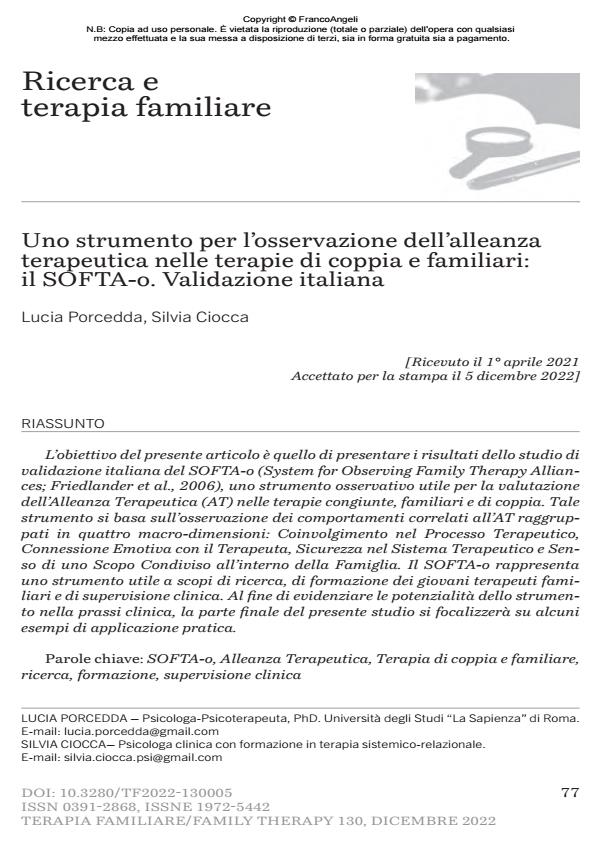Uno strumento per l’osservazione dell’alleanza terapeutica nelle terapie di coppia e familiari: il SOFTA-o. Validazione italiana
Titolo Rivista TERAPIA FAMILIARE
Autori/Curatori Lucia Porcedda
Anno di pubblicazione 2023 Fascicolo 2022/130
Lingua Italiano Numero pagine 20 P. 77-96 Dimensione file 728 KB
DOI 10.3280/TF2022-130005
Il DOI è il codice a barre della proprietà intellettuale: per saperne di più
clicca qui
Qui sotto puoi vedere in anteprima la prima pagina di questo articolo.
Se questo articolo ti interessa, lo puoi acquistare (e scaricare in formato pdf) seguendo le facili indicazioni per acquistare il download credit. Acquista Download Credits per scaricare questo Articolo in formato PDF

FrancoAngeli è membro della Publishers International Linking Association, Inc (PILA)associazione indipendente e non profit per facilitare (attraverso i servizi tecnologici implementati da CrossRef.org) l’accesso degli studiosi ai contenuti digitali nelle pubblicazioni professionali e scientifiche
L’obiettivo del presente articolo è quello di presentare i risultati dello studio di validazione italiana del SOFTA-o (System for Observing Family Therapy Alliances; Friedlander et al., 2006), uno strumento osservativo utile per la valutazione dell’Alleanza Terapeutica (AT) nelle terapie congiunte, familiari e di coppia. Tale strumento si basa sull’osservazione dei comportamenti correlati all’AT raggrup- pati in quattro macro-dimensioni: Coinvolgimento nel Processo Terapeutico, Connessione Emotiva con il Terapeuta, Sicurezza nel Sistema Terapeutico e Sen- so di uno Scopo Condiviso all’interno della Famiglia. Il SOFTA-o rappresenta uno strumento utile a scopi di ricerca, di formazione dei giovani terapeuti fami- liari e di supervisione clinica. Al fine di evidenziare le potenzialità dello strumen- to nella prassi clinica, la parte finale del presente studio si focalizzerà su alcuni esempi di applicazione pratica.
Parole chiave:SOFTA-o, Alleanza Terapeutica, Terapia di coppia e familiare, ricerca, formazione, supervisione clinica
Lucia Porcedda, Uno strumento per l’osservazione dell’alleanza terapeutica nelle terapie di coppia e familiari: il SOFTA-o. Validazione italiana in "TERAPIA FAMILIARE" 130/2022, pp 77-96, DOI: 10.3280/TF2022-130005